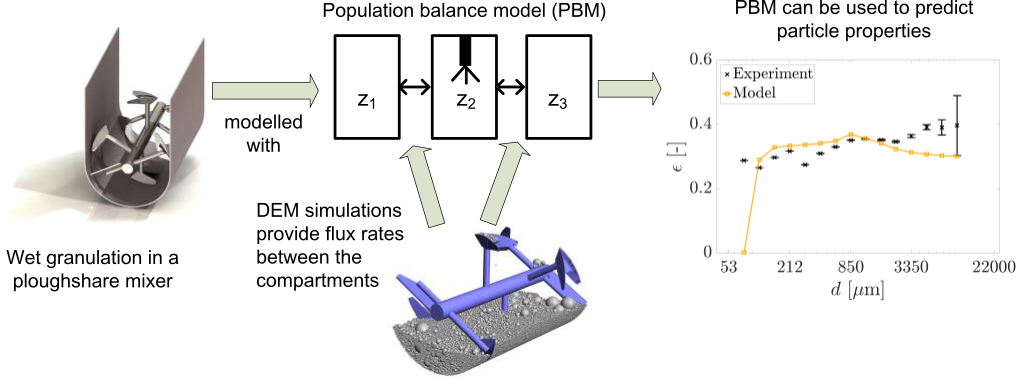Development of a multi-compartment population balance model for high-shear wet granulation with Discrete Element Method
Highlights
- A granulation process is modelled using a population balance model (PBM) and DEM.
- Particles in the population balance model are five-dimensional.
- The population balance model has 3 compartments to consider spatial inhomogeneity.
- The PBM is used to model particle size and porosity distributions.
- The performance of the PBM is improved by utilising information from DEM.
Abstract
 This paper presents a multi-compartment population balance model for wet granulation coupled with DEM (Discrete Element Method) simulations. Methodologies are developed to extract relevant data from the DEM simulations to inform the population balance model. First, compartmental residence times are calculated for the population balance model from DEM. Then, a suitable collision kernel is chosen for the population balance model based on particle-particle collision frequencies extracted from DEM. It is found that the population balance model is able to predict the trends exhibited by the experimental size and porosity distributions by utilising the information provided by the DEM simulations.
This paper presents a multi-compartment population balance model for wet granulation coupled with DEM (Discrete Element Method) simulations. Methodologies are developed to extract relevant data from the DEM simulations to inform the population balance model. First, compartmental residence times are calculated for the population balance model from DEM. Then, a suitable collision kernel is chosen for the population balance model based on particle-particle collision frequencies extracted from DEM. It is found that the population balance model is able to predict the trends exhibited by the experimental size and porosity distributions by utilising the information provided by the DEM simulations.
Access options
- This paper draws from preprint 170: Development of a multi-compartment population balance model for high-shear wet granulation with Discrete Element Method
- Access the article at the publisher: DOI: 10.1016/j.compchemeng.2017.01.022



